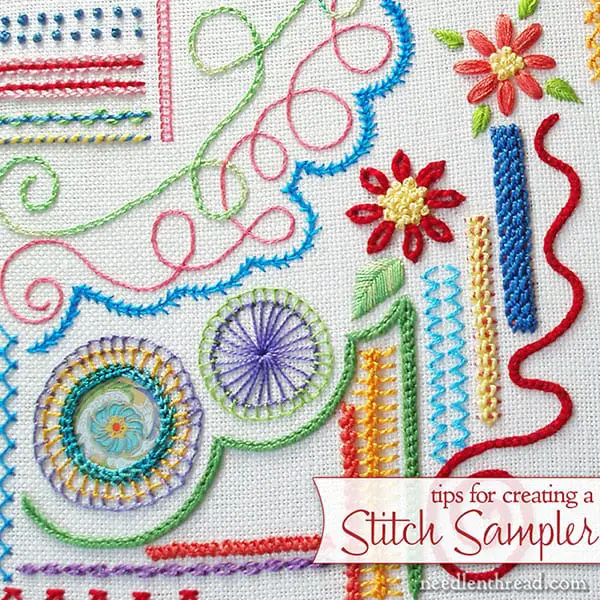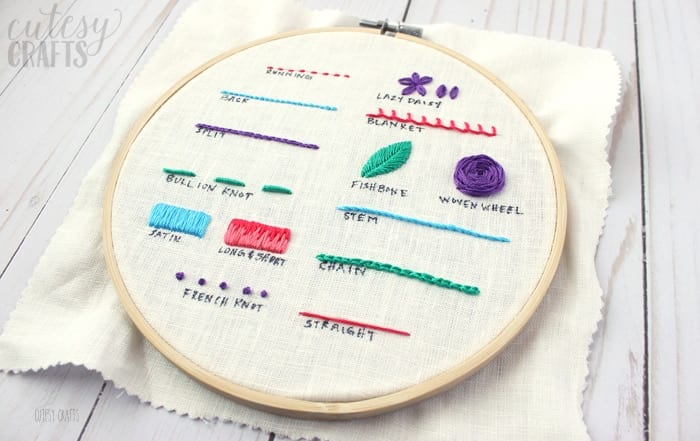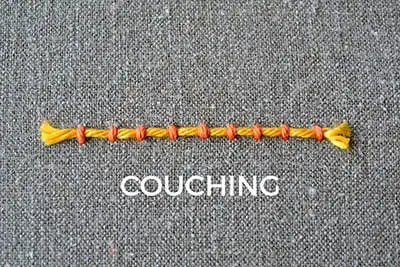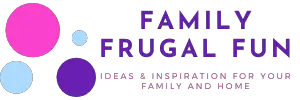
People are attracted to embroidery as it is both relaxing and fun. It can be considered an art form with thread and a needle. You may be daunted in starting, but you should know that most embroidery stitches are easy. You can easily get the hang of it.
The kinds of stitches that are shown here are not only for beginners but advanced beginners as well. Knowing them will give you enough skills to undertake any kind of embroidery projects.
Types of Embroidery Stitches

Running Stitch
It is the stitch that is used from clothing to embroidery. It’s so easy to learn. It is the basic element in Japanese sashiko embroidery. It adds details to your embroidery design, and it’s great for dashed outlines.
Although it’s considered very basic, you can make it complex by changing the length of the stitches. The second row of stitches can also be formed. It is best applied in wrapping and weaving too.
Back Stitch
It is made for the outline of the design before satin stitch, as well as various composite stitches, are added. It would also help you put fine details on your embroidery design.
Split
It is one of the basic stitches, and it is applied for delicate curves and lines. It’s the upside-down version of the backstitch. It looks pretty good with outlining designs specifically for floral stems. It appears like a chain when it’s continuously done.
Bullion Knot
If you’re into flower design, the bullion knot is a must-learn stitch. It’s the basic in making all kinds of roses in just any fabric. You can consider it an advanced embroidery stitch, but learning it is for the sake of a neat touch of flower designs. It would only take long stitches of French knot. Voila, you’ll have your bullion knot.
Satin
It brings out texture on your embroidery design. It’s easy to execute to aim for covering some designs like leaves. You will use straight stitches on the outline of the design so as to make it look natural. Then start doing satin stitches for a smooth and satin-like outcome.
The technique to make it more look appealing is attaining the right length and proximity. It results in stunning shape and form.
Long & Short
It’s a way of filling embroidery designs and large areas like leaves and flower petals. You need to make alternate stitches which are composed of long and short ones. The first thing you need to accomplish is the first row, then proceed to the last part. Once you complete the design, it will look like it’s packed with short and long fillings.
French Knot
It’s one of the challenging stitches that you need to learn. It may consume a lot of time, but it’s all worth it in the practice of embroidery. You can always see it as it is required by most designs. It is also used for certain design elements as it gives some texture.
To achieve the French Knot, you have to wrap the thread on the needle to come up with a knot of the fabric. You have to tautly hold the thread, but it shouldn’t be too tight. Keep on practicing until you master it.
Lazy Daisy
It’s obviously for petal and floral designs. Stitches are not made continuously as you need to make a loop. Then you have to make small stitches at the end of the loop. It would give you a form of daisy petals.
Blanket
It can be tricky at first, but once you know how to do it, you will think of it as a basic stitch. It is used for gaining the applique’s edge. It works well with decorative lines and borders. You can create variation by adding spacing and changing the height.
Fishbone
It is a kind of stitch that is used for making a leaf or a feather. The pattern has two parts that are being filled alternately. It forms a pleated effect in the middle.
Woven Wheel
You may be intimated upon seeing a finished pattern of the woven wheel. It looks like an intermediate stitch, but it has a simple process. Straight stitches should be utilized for this as you work your way on making a flower. With continuous straight stitches, you will fill your hoops with floral design.
Stem
It’s another basic stitch that works wonderfully with a smooth outline. It goes along with both straight and curved lines. As its name suggests, this is made for stem design. But you can adjust the length and use it to fill other designs.
Chain
If you want a bolder stitch so this is the one you should use. You can create a row of stitches that are linked together. It can be made in several ways, like having it forward, and the reverse way is also practiced. Once you master it, you can try other variations.
Straight
There’s no need to have an explanation in making this stitch. It’s bringing the needle up beneath the fabric, then pulling it up to the surface, then putting it back again. It’s the building block of embroidery stitch so you can make variations. It is used to make stars, textures, scattered fills, and many more. It’s a versatile stitch, so you need to work on length and placement to create various designs
Feather Stitch
It has the nature of getting linked too from open lines that seem to be moving. It is best used for borders and frames. It has a function of embellishing other stitches, and it contributes to the enhancement of a well-layered stitch. It goes with the creation of foliage, seaweed, scales, feathers, and other various designs to make it come along as a natural thing.

Couching Stitch
It’s not so basic, but everyone who does embroidery should know this. Two threads are used at the same time for this kind. One thread is on the surface while the other remains in the tacking stitches. It can fill an area, form a texture, and make outlines. It is even applied to ribbon and yarn making.
Detached Chain Stitch
It is something connected with flower design making. But it can be used with other designs like leaves. It is formed by the structure of the chain, but it is only a single link. With 5 or 6 chain stitches, you can come up with a Lazy Daisy stitch.
Fly Stitch
It is done like a detached chain, but it comes out in V shape or a soft curve. So it appears like a teardrop. It can be compiled in a row or stitched in a radius. You can always create other variations.
Seeds
It’s the same way when you do the straight stitches, but it is being scattered. But you should practice the state of being even to its length and space. They go to random directions. It is a filler stitch that can represent grassy areas, sprinkles, animal fur, and more.
Summary
These are the embroidery stitches that are commonly used, and they can help you enhance your skills. You need to always start with these to create fancy designs and patterns.
